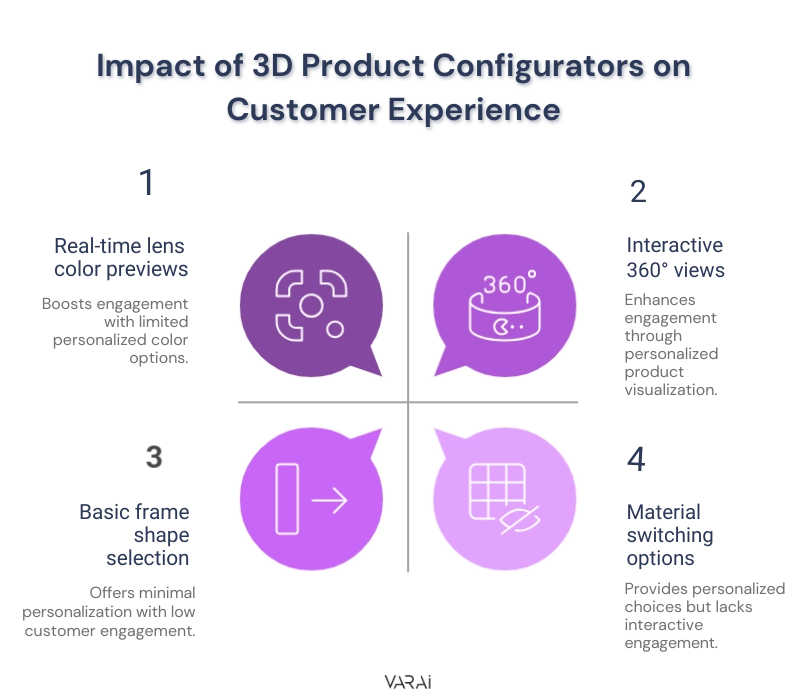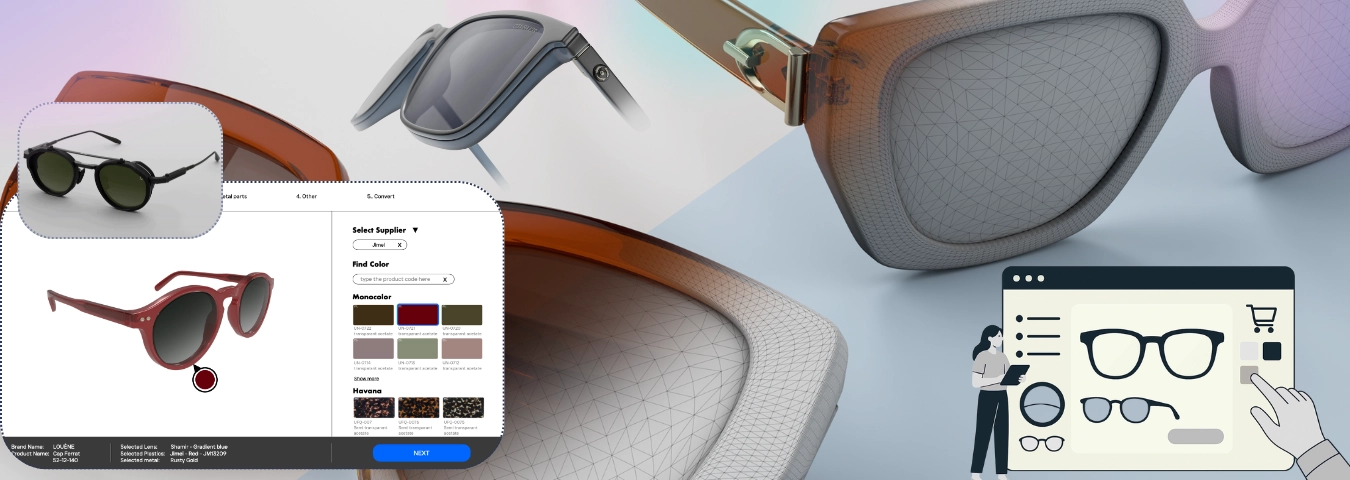Personalization is big and a priority for any B2C and B2B businesses nowadays. The reason? The rise of product configurators has made hyper-personalization easy to get and generates unique experiences. Giving customers that “made for you” and “just for you” experience is what successful brands are using.
A 3D product configurator is software that allows users to change colors, materials, sizes, features, and design elements. It helps shoppers and clients to visualize the product before it is physically available to them for purchase. This ability to create 3D renderings builds confidence and reduces uncertainty.
In fact, a McKinsey Study found that businesses offering personalization generate 40% more revenue than their competitors. Why? Because customers are no longer guessing. Instead, they’re making informed, visual-based decisions.
But, is increased revenue the only benefit of using a 3D product configurator? Not at all. We will break down all the reasons why e-commerce businesses should use product configurator software. If you have questions like “Do I need a product configurator?”, keep reading to get them answered!
TL;DR – An e-commerce 3D product configurator improves visualization, personalization, social sharing, trust, repeat purchases, complex selling, pricing, data collection, sales independence, and ERP/CRM integration. This makes 3D product customizers a must for modern businesses.
What is a 3D Product Configurator?
A 3D product configurator or technology is a tool that helps you offer customizations of your products directly to your customers or clients. Many small businesses, e-commerce platforms, and business-to-business operations require some form of a configurator for product visualization.
B2C businesses can expect to increase their sales, engagement, and reduce return rates. B2B platforms can also expect to get help with product pitches, wholesale operations, and offer realistic inventory to reduce waste.
Market trends strongly support this shift toward personalization. Over 50% of consumers now prefer some form of customization and are willing to pay more for them. That’s why newer modern businesses can no longer afford to ignore the clear product configurator benefits in e-commerce.
Why Do Businesses Prefer Product Configuration in E-commerce?
There are many reasons why e-commerce businesses choose product configurators. Sometimes customization is the main goal, while other times the need for visualization is greater to help users better understand their end product. Below, we’ve expanded on the top 10 product configurator benefits in e-commerce for both B2B and B2C clients.
1. Makes Online Shopping More Visually Intuitive
For anyone shopping online, purchasing a product without seeing it in person can be challenging. A 3D product configurator helps by allowing shoppers to preview the product they are interested in, like sunglasses, before they click to buy. Most configurators allow people to look at textures, color combos, and product variations.
Static photos can’t match the accuracy of visual product configurators. Also, post-purchase disappointment is very common in online shopping, which gets handled via an e-commerce product configurator. This visual clarity can help your business offer digital access to your product and help your brand stand out from the crowd.
2. Allows Shoppers to Co-Create Products
Modern consumers crave uniqueness. To deliver these non-replicable experiences, brands can integrate 3D product configurator software. Though originally built for designers and manufacturers, configurators can let consumers personalize design elements.
This can include the color, features, size, and more of a product. Customization to this level helps to target the emotions of buyers by making a product into “their” product. It adds perceived value and boosts conversions and loyalty for the long term.
3. Create Shareable Moments for Social Media
For consumers to fully enjoy personalization, they often want to share it with others. 3D models and configurations let people show off their newer customized products through social media channels. These turn their purchases into experiences that resonate more.
Social sharing is a part of this that can always help with brand awareness and generate organic traffic. Brands can build viral campaigns around their 3D product configuration tools. Influencers can promote their custom creations, inspiring others to try the “design your own” experience.
4. Builds Trust by Showing Product Accuracy
One of the biggest challenges that e-commerce websites face is ensuring product accuracy. Simply listing dimensions isn’t always effective. Many customers overlook this info, leading to negative reviews. To solve this, brands can use 3D configuration and technology.
Lifelike previews display textures, materials, and dimensions clearly, helping shoppers make confident decisions and finalize their purchases. Brands can also create 3D renderings that serve as digital twins or prototypes, offering added detail where needed.
5 . Inspires Repeat Purchases with Variations

Customers often favor a particular style or design and want to purchase similar items in different colors or versions. This behavior presents an opportunity for repeat business.
How eyewear e-commerce brands use 3D product configurators:
- Allow customers to choose from multiple frame shapes and styles.
- Let users switch between materials like acetate and metal.
- Enable real-time preview of lens colors and finishes.
- Provide interactive 360° product views for better visualization.
- Help reduce return rates by setting accurate expectations.
- Boost customer engagement through a fun, personalized shopping experience.
3D configurators make it easy and engaging to mix designs and explore variations. A shopper might create seasonal versions of their favorite sunglasses or bags using a 3D configurator. This can further drive sales and engagement.
6. Simplifies Selling of Complex Configurable Products
Manufacturers, designers, and B2B retailers often struggle to display their products, such as machinery, signage, furniture, or technical gear in full detail. A reliable 3D configurator offers a clean and interactive visualization to businesses.
The company’s sales representatives can walk their clients through the multiple options, components live and offer self-configure for any changes required. This simplification shortens the sales cycle and reduces dependency on manual quoting or back-and-forth clarification.
7. Configurator Automates Pricing Based on Custom Features
Businesses frequently request wholesale pricing because of the high volume supply they need for further business strategy. These product configuration tools can be used along with pricing engines to help produce instant custom quotes and selective changes.
Buyers can get clarity on costs in real time, reduce sales friction, and avoid the long delays on deal approvals. can easily bundle upgrades, add-ons, and premium features into the quote, making the buying process smoother.
8. Collects Client Preferences for Unique Proposals
Your product configuration in e-commerce is always unique to your business model. As a global retailer, you may need to collect thousands of data points, while a small manufacturer may not need much data to compile the latest eyeglasses or other product collections.
Advanced 3D configurators for products capture data on size, function, and style preferences. This useful data can help sales teams prepare better proposals for offering custom solutions. These configurators can also be used for identifying patterns across industries and optimizing future offerings for better operational efficiency.
- Example in Practice: An eyewear brand used 3D configurator data to identify top frame preferences and launched a tailored collection based on seasonal trends.
- Why it Matters: Enables data-driven personalization, faster planning, and targeted proposals.
9. Reduces Dependency on Sales or Support Teams
Instead of needing a representative to walk through each product option or a designer to generate every mockup, B2B clients can use configurators for self-service. With minimal guidance and a comprehensive 3D product configuration, brands and companies can make the process of requests direct and easy.
Clients will get the space to experiment with specs, visualize configurations, and make informed choices without waiting. This also frees up internal teams for strategic tasks rather than repetitive inquiries. Distributors, resellers, international buyers, or manufacturers can find configurators extremely helpful for all time access across different time zones.
10. Configurator Integrates Ideally With ERP and CRM Systems
Product Configurator benefits in e-commerce are greater than you may think. One of the most impactful advantages of B2B use is how a 3D configurator integrates with ERP (Enterprise Resource Planning) and CRM (Customer Relationship Management) systems.
If well executed, this creates an end-to-end solution that manages everything from orders flow directly into fulfillment pipelines, reducing errors and speeding up processing. Businesses can fully automate processes, improve accuracy, and scale more efficiently with the help of product configurator software.
This flowchart explains the configurator’s functionality better:
Start
↓
Customer Uses 3D Configurator to Customize Product
↓
Order Data Automatically Syncs with ERP & CRM Systems
↓
ERP Handles Inventory, Production & Fulfillment
↓
CRM Updates Customer Profile & Sales Records
↓
Automated Processing Reduces Errors & Delays
↓
Business Gains Efficiency, Accuracy & Scalability
↓
End-to-End Workflow Optimization
Answer to the Question “Do I Need a Product Configurator”?
Every business and client interested in offering customizations to its end users needs a 3D product configurator. The ability for businesses to boost interactivity and for customers to visualize their final product is key to driving market growth.
However, not all 3D configurators for products are made equal. Some product configurator software offers better performance, features, and integration than others. Before choosing a solution, it’s important to take a trial, explore the full feature set, and compare pricing to determine which 3D product configurator best fits your business needs.
A 3D Configurator That Helps You Customize Eyewear Styles
At VARAi, we understand the importance of a reliable 3D Product Configurator. Our 3D product configurator software for eyeglasses enables designers, manufacturers, retailers, and stakeholders to collaborate in one place. You can review live changes, enhance designs, and launch collections up to 9 months in advance.
Our configurator comes with powerful features, such as:
- Customize frames in real time with multi-person collaboration
- Showcase transparency, reflection, and textures with 1:1 accuracy
- Instantly access acetate and metal samples from our pre-built material library
- Replace physical samples with interactive 3D previews of digital prototypes
- Automatically calculate material costs during design sessions and sales pitches
- Pull live pricing from trusted vendors or add your custom materials
- Discover trending colors, shapes, and materials through detailed data tracking
- Monitor preferences by customer demographics or location
- Sell or license 3D models and configurations for marketing across platforms
- Adjust quotes based on live material or product availability
- Identify cost-effective, high-return materials for accessible yet premium collections
- Cut prototyping time from 90 days to just 5 with detailed 3D renderings
- Streamline collaboration with fewer revisions among teams
- Mix acetates, metals, and colors on one model to experiment freely
- Simple plug-and-play setup with no code or developer required
Explore the smartest way to design and sell eyewear.
Try VARAi’s 3D Product Configurator today and bring your next collection to life.

